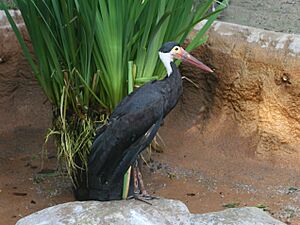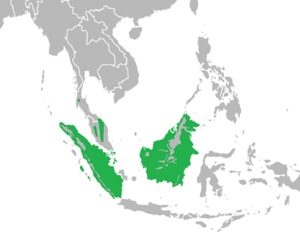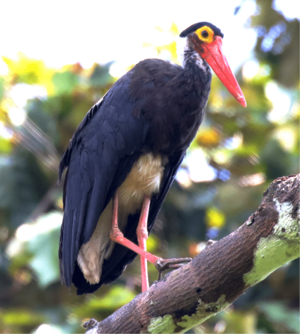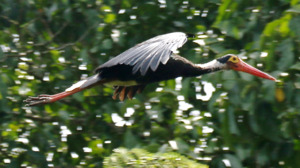Storm's stork facts for kids
Quick facts for kids Storm's stork |
|
|---|---|
 |
|
| At San Diego Zoo | |
| Conservation status | |
| Scientific classification | |
| Genus: |
Ciconia
|
| Species: |
stormi
|
 |
|
| Extant resident range | |
The Storm's stork (Ciconia stormi) is a special bird found in the warm, wet forests of Indonesia, Malaysia, and southern Thailand. It's a medium-sized stork, but it's super rare! Scientists think there are fewer than 500 of these storks left in the wild. Their numbers are shrinking mostly because their forest homes are being cut down.
Contents
Meet the Storm's Stork
This stork was first described by a scientist named Blasius in 1896. He named it after Hugo Storm, a German sea captain who collected animal samples. In Thailand, people call it "nok kra su um." This name describes how the bird hunts by quietly walking along riverbanks in thick forests.
The Storm's stork looks a lot like its close relative, the woolly-necked stork. Sometimes, people even thought they were the same kind of bird! But the Storm's stork has a special yellowish-orange patch of skin around its eye. The woolly-necked stork doesn't have this. Also, the Storm's stork has a black and white neck, while the woolly-necked stork's neck is all white.
These two storks also live in different places. Storm's storks prefer dense forests. Woolly-necked storks usually live in open swamps, rice fields, grasslands, and farmed areas. They can sometimes be found in the same places, like Sumatra, where both types of habitats exist. Scientists have also studied their genes. This research shows that the Storm's stork and the woolly-necked stork are indeed very close relatives.
What Does a Storm's Stork Look Like?
This medium-sized stork stands about 75 to 91 centimeters (2.5 to 3 feet) tall. Most of its feathers are black. Its belly feathers and the back of its neck are white, but it has a black cap on its head.
It has orange skin on its face with a yellow ring around its eye. Its eye itself is red, and its beak is pinkish-red. Some male storks have a slightly curved beak with a small bump at the bottom.
The legs and feet of adult storks are a dull red. They often look paler because they get covered in the birds' droppings. During the breeding season, their beak and other soft parts become darker. Males and females look similar, but males are usually a bit bigger. Some people think the male's black cap, chest, and throat might be a bit shinier too.
Chicks and Their Growth
When chicks are 1 to 3 days old, they are completely white. They have a black crown on their head and a black beak with a yellow-orange tip. Their legs, facial skin, and throat pouch are light yellow at first. As they get older, their legs turn pink, and their facial skin becomes dark gray. Their eyes are initially brown.
Storm's stork chicks grow very quickly! They double their size in less than a month. By this time, they start to grow black feathers on their wings, throats, and bodies. After 30 days, they have even more black feathers. Their black chest and wing feathers might even have shiny green and bronze-red streaks.
After 45 days, young storks look a lot like adults. But they are still smaller. Their beaks are shorter and have dark tips. Their skin colors are paler, and their black feathers are not as shiny. Chicks are fully feathered after 52 to 57 days. Wild young storks usually leave the nest after about 60 days. Storks raised in zoos can usually fly after 90 days.
Sounds and Calls
Adult Storm's storks are usually quiet when it's not breeding season. But during breeding time, they make sounds that people describe as "Kurau." In zoos, one adult stork was heard making a quiet whistling sound. Chicks make a loud, frog-like begging call when their parents return to the nest with food.
Where Do Storm's Storks Live?
Most Storm's storks live on the island of Borneo. You can find them in Kalimantan (Indonesia), Sarawak, Sabah (Malaysia), and Brunei. They also live throughout Sumatra, though people used to think they only lived in the southeast part of that island. Even though they are found across these islands, there aren't many of them in any one place. Usually, only one or a few storks are seen together. The most ever seen at once was 12 in Brunei.
Smaller numbers live in parts of peninsular Malaysia, where they are very rare. Even fewer live in the very south of Thailand. It's unlikely they live anywhere else in Thailand because there isn't much suitable forest left.
In 1986, the first Storm's stork nest ever known to science was found in Southern Thailand. However, a dam was built that same year, which flooded and destroyed much of the stork's forest home. After the flooding, people thought Storm's storks no longer bred there and might even be extinct in Thailand. But in 2004, they were seen again using infrared camera traps! They are still very rare, with usually only one stork seen at a time. Still, finding them means a small group might still be breeding there.
Their Forest Home
This stork mostly lives in dense lowland riverine forests and peat swamp forests. These are forests near rivers or in swampy areas, usually not higher than 240 meters (about 787 feet) above sea level. These forests have many large trees. The undergrowth is full of plants like rattans, bamboos, and shrubs. It's hard for humans to get into these habitats. This is one reason why we don't know much about the Storm's stork's life.
Storm's storks live in both lowland riverine forests and peat swamp forests. We don't know which type of forest is best for them. But peat swamp forests seem to be very important for these storks. As humans continue to cut down lowland riverine forests, peat swamp forests might become a safe place for the storks. There's a large area of peat swamp forest in West Kalimantan. However, these forests are also in danger. They are being cleared for palm oil plantations, logging, and forest fires. So, we need to work hard to protect these peat swamp forests.
Storm's storks can sometimes live in forests that have been logged. But scientists disagree on how good these areas are for them. Some think they can't breed well in logged forests, even if they survive there for a short time. We need more time to see if logged forests are truly good for them in the long run. For logged forests to be useful, storks probably need easy access to freshwater. Also, the forest might need at least 20 years to grow back before it becomes good habitat again. Sometimes, storks might survive in logged areas if there are still untouched patches of forest nearby where they can find refuge.
This stork is often seen flying high above rivers and open areas in the forest. Like many other storks, they use warm air currents (called thermals) to help them glide. This behavior is "contagious." When one stork starts to soar, others often join in. Flocks can have up to six storks flying together.
On Borneo, they have also been seen in open, grassy freshwater swamps and rice fields. They never seem to visit salty water areas. But they sometimes use forested inland areas near water that has tides, and near mangrove swamps.
Life Cycle and Habits
Reproduction and Nests
We have two main records of Storm's storks breeding. One was in southern Thailand in 1986, and the other in a swamp forest in southern Sumatra in 1989. In Thailand, chicks were seen in October. In Sumatra, they were seen in early June. This means they don't have a strict breeding season. It's hard to find their nests in the dense forest, so we don't have many breeding records.
The nest is usually built high up, about 19 to 30 meters (62 to 98 feet) above riverbanks. They often build them in the forks of large trees. One nest in south Sumatra was studied. It was 8.3 meters (27 feet) high in an 18-meter (59-foot) tall tree. In zoos, both the male and female storks help build the nest.
The nest is usually 30 to 50 centimeters (12 to 20 inches) wide and 10 to 15 centimeters (4 to 6 inches) deep. It's made of twigs and sticks. The inside of the nest is lined with soft materials like grass. Storks often use the same nest year after year. Both parents add more material to the nest each year.
Storm's storks usually stay with one partner for life. Both parents take care of the young in the nest. But usually, only one parent is there at a time. The female spends about three times as long alone at the nest as the male. When the chicks are very young, both parents sleep at or near the nest in the evening. But after about a month, only the female continues to sleep there.
Unlike what some people thought, these storks seem to breed alone, not in groups. However, they sometimes gather to roost (rest) together. Several storks have been seen roosting in the tops of tall swamp trees a few kilometers from their nests.
Usually, two eggs are laid each year. The eggs hatch after about 29 days. Both parents take turns sitting on the eggs to keep them warm. In zoos, a pair might lay between two and four eggs. The young storks can fly about 90 days after hatching. The only Storm's stork egg ever measured was infertile. It was found in 1989 in a nest with two hatched chicks. This egg is now kept at the Zoological Museum of Bogor in Indonesia.
Courtship Displays
Pairs of Storm's storks do amazing aerial dances to attract each other. Both birds do flips in the air. The lower bird might even show its feet to the one above. They also sometimes glide high up with flat wings and dangling legs. At the nest, they make clattering sounds with their beaks. This is common for many stork species.
In zoos, another courtship display has been seen. Both storks face each other on the ground or in the nest. They spread their wings out and bow to each other many times. This continues until the male tries to mate with the female. This display sometimes continues even after the chicks have hatched. We don't know how important this display is for wild storks. Parents are only seen together at the nest about 2% of the time.
Food and Eating Habits
Storm's storks mainly eat small fish, frogs, water insect larvae, and sometimes earthworms. These are also the foods that parents bring back for their young in the nest. The fish are usually 5 to 7 centimeters (2 to 3 inches) long and weigh 10 to 30 grams. The worms are 10 to 15 centimeters (4 to 6 inches) long. Parents spit the food into the bottom of the nest, and the chicks pick it up and swallow it.
During observations in southern Sumatra in 1989, adults brought food to the nest every 2 to 4 hours in June. But in July, they brought food less often, and mostly in the late afternoons. In Sabah, they have also been seen eating grasshoppers and possibly crabs. They might eat other foods similar to the woolly-necked stork, but we need more information to be sure.
This stork usually hunts quietly. It moves slowly and carefully with its neck pulled back. It hunts along muddy banks of rivers and creeks in dense forests, mostly staying in shaded areas. Storks with chicks usually hunt 2 to 3 kilometers (1.2 to 1.9 miles) away from the nest. They also use other freshwater places with lots of fish and water insects. These include small pools, puddles near paths, swamps, and oxbow lakes. They might use these spots best when they are scattered around river floodplains. They can also use muddy clearings made by animals like gaur that stomp down plants to reach mineral licks. They avoid deep, fast-flowing rivers because there isn't much food there, and they can't stand in the water.
In Sabah, they have been seen feeding on open ground that has recently burned. They probably catch insects that were disturbed or killed by the fire.
Threats to Storm's Storks
The biggest danger to Storm's storks is the destruction of their lowland forest homes. These forests are being cut down for logging and to make way for palm oil plantations. For example, about two-thirds of the swamp forests in South Sumatra were logged between 1982 and 1997. Kalimantan lost almost 25% of its evergreen forest from 1985 to 1997. All of Sumatra lost almost 30% of its forest cover from 1985. Lowland forests are often cleared first because they are easy to reach and have valuable timber.
Huge areas of their habitat have also been destroyed by flooding. This happens when dams are built, like the Chiew Larn Dam project in Southern Thailand. Since this stork lives only in lowland areas, forests on higher ground are not suitable for them. So, they can't just move to higher places when their homes are destroyed.
Cutting down forests might not directly hurt Storm's storks too much. They can fly long distances to find new homes. They might not be bothered by open land they fly over. However, this is probably not good for them in the long run. We don't know how far they will travel to find new habitat.
A bigger problem from deforestation is that there will be fewer freshwater animals for them to eat. When forests are logged, more dirt washes into rivers, and water temperatures change. This reduces the number and types of fish and insects in the water. This means less food for the storks. Building roads through forests for logging also causes problems. It leads to soil washing away, which also reduces freshwater prey. Large gaps in the forest canopy from logging make the cleared areas drier. This makes it hard for animals like amphibians and insects, which need wet ground, to live there. This also reduces the amount of food for the storks.
Other Dangers
Another threat to this stork is hunting by humans. Local people might hunt them for food. When more people move into these areas to use the land, it attracts hunters from other places. So, hunting of these storks has also increased. This likely happened during the flooding in Southern Thailand for the Chiew Larn Dam project.
Storm's storks are also very sensitive to humans. If people come too close to their nest, the adult stork will leave. It won't come back until 2 to 3 hours after the person leaves. Loud noises from things like motorboats and chainsaws can also bother them. When they hear such noises, adult birds have been seen pressing their heads and bodies into the nest, with only their eyes showing.
Natural enemies of chicks and nesting adults include birds of prey like crested serpent eagles, monkeys, and corvids (like crows). If these animals get close to the nest, the parent will spread its wings over the nestlings to protect them.
A smaller threat is capturing storks for zoos around the world. This increased a lot in the late 1980s. While keeping Storm's storks in zoos can help the global population, these birds might become too used to humans. This means they might not be able to live in the wild again. In Singapore, the price of this stork in bird markets doubled in the early 1990s. However, there's no proof that they are traded internationally.
Storm's Storks and People
Sometimes, people hunt this stork for food. This can be done by people who live in the forest or by people who come to the area for logging or other projects. Even in untouched forest areas, where there aren't many people, some still collect forest products and hunt animals illegally. During these activities, Storm's storks are sometimes caught for food. This can happen directly by people who collect latex from the jelutong tree, or in traps set for monitor lizards.
Storm's storks have been seen in many zoos, like in Kuala Lumpur, Malaysia, and Walsrode, Germany. However, only two zoos have successfully bred this species: Zoo Negara in Malaysia and San Diego Wild Animal Park in California.
Protecting the Storm's Stork
The Storm's stork is a very rare bird. Its population is shrinking quickly, mainly because its natural home is being cleared for palm oil plantations and logging. It was probably never a very common bird, even before humans started destroying so much of its habitat.
Since 1994, it has been listed as Endangered on the IUCN Red List. Scientists believe there are only about 400 to 500 wild storks left. About 150 of these are thought to live in Malaysia, and about 250 in Indonesia. This species is legally protected in Indonesia, Sarawak, and Thailand. Even though these laws haven't always been strongly enforced, the stork has been seen in many protected areas across its range, especially in Kalimantan, Sumatra, and Malaysia.
This stork needs large areas of dense lowland forest to find food. So, the best way to protect it from disappearing is to create large protected areas. These areas should have untouched lowland forests and rivers. However, because this stork is very secretive, it's hard to study its life and habits. While we know that cutting down forests hurts them, we still don't know exactly how much human changes affect their homes.
Images for kids
-
At Zoo Miami







